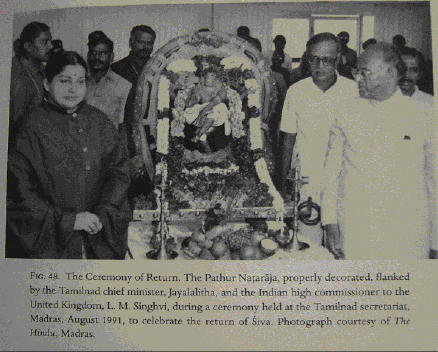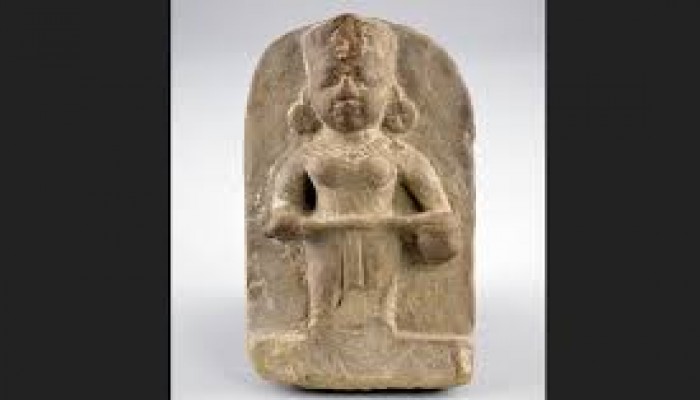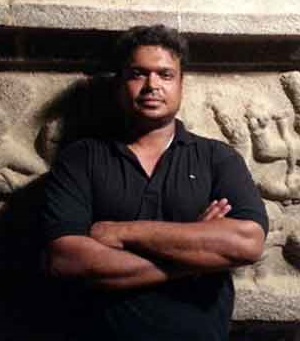Restitution of Annapoorna Devi Sculpture from Canada: “Nemo dat quod non habet “
- In History & Culture
- 10:29 AM, Dec 19, 2020
- Vijay Kumar
The recent virtual restitution of the 18th Century Annapoorna stone sculpture to India by The University of Regina Canada based on some fine work done by Artist Divya Mehra is a very welcome move
For starters that this distinctly feminine sculpture was displayed since the mid 1930’s as Vishnu in an academic institution of repute, the fact that she held a ladle and a bowl in her hands (and not the traditional conch, discus or mace of Vishnu) shows how little of displaced Indian art in Canada has been documented let alone studied properly.
Secondly, as per the feature released by the University – “The statue was part of the original 1936 bequest by Norman MacKenzie, the gallery’s namesake and when Mehra researched the story behind the statue, she found that MacKenzie had noticed the statue while on a trip to India in 1913. A stranger had overheard MacKenzie’s desire to have the statue, and stole it for him from its original location – a shrine at stone steps on the riverbank of the Ganges at Varanasi, India.” - the collector and gallery’s donor left the provenance, dodgy that it maybe, no one had bothered to even read the same, also shows the lack of collecting standards during those days and emphasises the importance of due diligence and provenance studies – an area neglected by most major museums.
The University has since clarified its stand and must be appreciated for the same - “Today, we conduct due diligence on the provenance of incoming artwork but will take steps to review objects that have been in our care before such standards were commonplace."
The High commission and the department of Canadian Heritage must also be complimented on their proactive steps to reach out to the University and facilitating the restitution.
Canada has in past restituted a similar orphaned Khajuraho ‘Parrot Lady’ in early 2017 but this time its Institutions seriously looked at their past acquisitions especially problem objects that have slipped through India’s weak past and often feeble attempts at combatting heritage theft.
A case in point is the much celebrated ‘London’ Pathur Nataraja case – a case taught to all Art History students and much celebrated by India. The champions who fought for its return in the British courts in 1982 bestowed with rare honors to this day. But the Pathur Nataraja’s triumphant return cloaks a rather murky secret – a brilliant victory that should have laid the foundations for a far reaching investigation was squandered. What emerged was repeated photo-ops and the system managed to erase vital details of the case from public memory.

Before we read on about the Pathur case in London, we need to see an interesting news that came up in November 2013 – an exhibition title ‘Many Faces, many Paths’ – celebrating the donation / semi-permanent loan of nearly 100 sculptures from Bumper Development Corporation Ltd., a private oil and gas company headquartered in Calgary. The company has donated nearly all the pieces in this gallery.
Robert M. Borden, Bumper’s founder, says large collections from a single donor are rarely displayed in museums, which is why the Glenbow asked him for an introductory statement for the exhibit.
It read: “The gallery you are entering contains an exhibit of objects that are works of art, not just cultural artifacts. For those of you who wish to view it as an ethnological exhibit or as a religious experience, information is provided alongside each object and you may seek to extend your knowledge through further study. However, in the eyes of this collector, the exhibit is first and foremost, one of art.”
Now what is the connection between the Glenbow Museum’s collection and the London Nataraja? – Bumper Development Corporation. The Pathur Nataraja was part of buried hoard unearthed by a farm labourer in Aug/sept 1976 near the ruined Arul migu Viswanatha Swamy temple in Pathur, Tamil Nadu. The farmer was dishonest and sold it to the smuggling lobby which via a Bombay dealer smuggled him into London eventually to be offered for sale by a London dealer Sherrier (who was also found to have produced false provenances for the Nataraja) who in turn sold it to Bumper Development Corporation. It was only when the Bronze was sent to the British Museum for conservation that doubts were raised as there were still mud and encrustations on it as evidence of recent removal from the ground and the Metropolitan police were informed leading to a seizure in 1982 and information petered down to the Indian Government to file a suit.
The courts eventually ruled in favour of India in a landmark judgement in 1988 and the Nataraja made a triumphant return to India – but then the Archaeological survey of India was requested to inspect the idols and issue certificate of Antiquity on 26.8.91. After several reminders and personal contacts, it was only after 8 years on 21.8.98 the Expert Committee from New Delhi visited Thiruvarur and inspected the idol and then issued the Antiquity Certificate 5 months later on 20.1.99. Sanction of Prosecution was accorded after another one year on 4.5.2000
The case in India is closed as under “The accused concerned in this case are arrested and convicted.” – But India never chose to investigate the Bombay dealer, the London dealer, the Canadian Corporation!
The pertinent question is will the Glenbow Museum publish the provenance of the donations from Bumper development corporation and do a proper due diligence.
Mehra titled her show at the museum “From India to Canada and Back to India (There Is Nothing I Can Possess Which You Cannot Take Away) – Maybe it should be “nemo dat quod non habet ‘ for the Glenbow Museum - The nemo dat rule is that the transferor of goods cannot pass a better title than he himself possesses!
|
|
|
Alex King, Dr. Thomas Chase, and |
Dr. Siddhartha V. Shah, Curator of Indian and South Asian Art at the Peabody Essex Museum, identified the statue as the Hindu goddess Annapoorna. She holds a bowl of kheer (rice pudding) in one hand and a spoon in the other. These are items associated with Annapoorna, who is the goddess of food and the queen of the city of Varanasi. She is celebrated by her devotees as one who nourishes and strengthens the body through food, and the soul through enlightenment.
Sources
https://calgaryjournal.ca/2013/11/30/glenbow-museum-gallery-sends-mixed-messages/
https://www.uregina.ca/external/communications/feature-stories/current/2020/11-19.html
http://webster-smalley.co.uk/ArchyWiki/London_Nataraja
http://www.e-books-chennaimuseum.tn.gov.in/chennaimuseum/images/158/files/basic-html/page195.html
Image Credit: The Financial Express








Comments